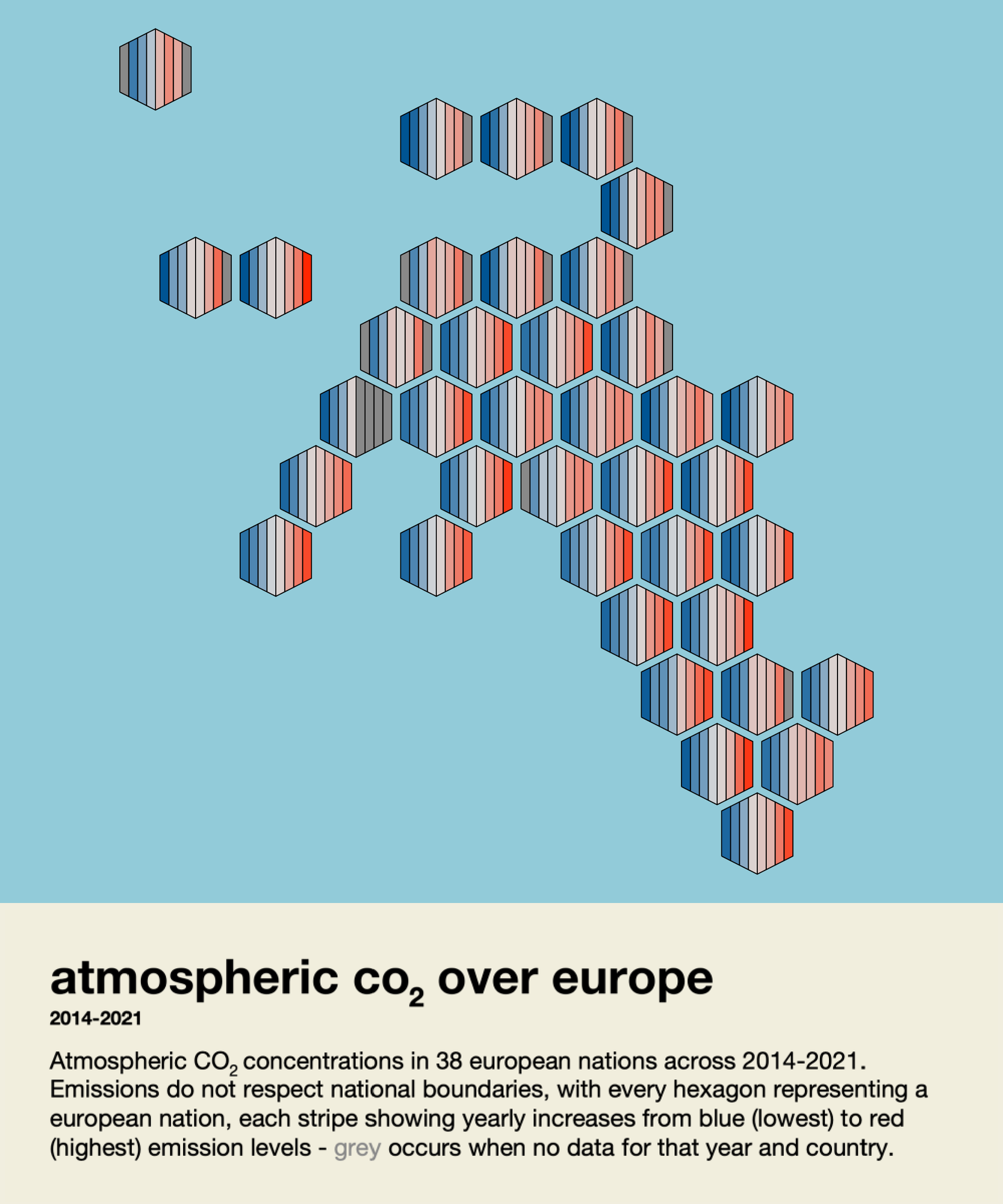Little Picture - Atmospheric carbon dioxide over Europe 2014-2021
A little picture by Neil Richards
The Little Picture depicts atmospheric carbon dioxide (CO2) concentration and highlights that it does not respect national boundaries, with every country in Europe showing similar increases in CO2 concentration regardless of size, location or individual CO2 producing activities.

About
This Little Picture shows countries in Europe (excluding Luxembourg) in the form of hexagons, approximating their geographical positions on the continent. Within each hexagon are 8 stripes, one for each year between 2014-2021 and are coloured by atmospheric volume of CO2 for the corresponding country ranging from blue (low) through to red (high). The colour scheme is intentionally similar to the iconic Warming Stripes (from Ed Hawkins/University of Reading).
Judges commendation
- Nice idea to arrange the hexagons in a stylised map of Europe
Data
Neil used monthly atmospheric XCO2 data for European countries (https://github.com/littlepictures/datasets/commit/62aefa2839cb624d31d3dbe17d33d1308c42c60f#diff-6a3e9155d2f5cff92bbd9e950f68cc3f270451a9c4be298ff5a029ca651cb3df). These data were derived from global atmospheric XCO2 satellite datasets produced by the ESA Climate Change Initiative (CCI) Greenhouse Gas project. The various data products produced are available via the CCI Open Data Portal https://climate.esa.int/en/odp/#/project/greenhouse-gases
Script
To create his Little Picture, Neil used Tableau. The workbook is freely available for download from https://public.tableau.com/app/profile/neil.richards/viz/climatepictures/stripes. The hex tile map of Europe was custom-built by Neil.
Licence
This Little Picture is published under CC BY-SA 4.0 licence.
The big picture
The European Space Agency (ESA), the European Centre for Medium-Range Weather Forecasts (ECMWF), and the European Organisation for the Exploitation of Meteorological Satellites (EUMETSAT) work closely together to measure, process & make space-derived information about the climate available.
ESA
The mission of the Climate Change Initiative (CCI) is to realise the full potential of the long-term global Earth Observation archives that the European Space Agency (ESA), together with its Member states, has established over the past 40 years, as a significant and timely contribution to the climate databases required by the United Nations Framework Convention on Climate Change. The ESA Climate Office provides a free & open CCI data facility bringing together ECV data from across its twenty-seven climate science projects, including a CCI Data Standards and a CCI Toolbox.
ECMWF
The Copernicus Climate Change Service (C3S) supports society by providing freely available authoritative information about the past, present and future climate in Europe and the rest of the World. C3S is one of the six thematic information services provided by the Copernicus Earth Observation Programme of the European Union, and has been entrusted by the European Commission to the European Centre for Medium-Range Weather Forecasts (ECMWF). One of the core components of C3S includes the Climate Data Store (CDS). This is a one-stop shop for climate information. It provides free and easy access to a wide range of climate datasets via a searchable catalogue. A freely available online toolbox allows users to build workflows and applications suited to their needs.
EUMETSAT
EUMETSAT operates missions both to provide weather and climate data for its member states, and as an entrusted entity under the Copernicus programme. Several missions are operated collaboratively with ESA, providing complimentary expertise and data processing, to process and distribute land, marine, and atmosphere relevant products for users. Data from EUMETSAT operated missions is frequently available in near-real-time, facilitating rapid monitoring and forecasting. Via EUMETCast, the EUMETSAT Data Services, or WEkEO, users can access data in ways that suit their needs. The data is used by the EUMETSAT satellite applications facilities, as well as across the various Copernicus Services.
next

